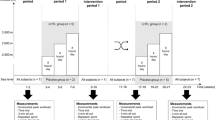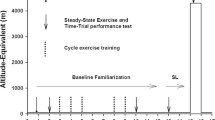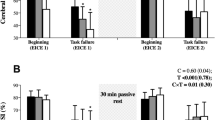Abstract.
The purpose of this study was to examine the effect of intermittent training in a hypobaric chamber on physical exercise at sea level. Over a 10 day period, 16 male triathletes trained for 2 h each day on a cycle ergometer placed in a hypobaric chamber. Training intensity was at 60%–70% of the heart rate reserve. There were 8 subjects who trained at a simulated altitude of 2,500 m, the other 8 trained at sea level. A year later, a cross-over study took place. Baseline measurements were made on a cycle ergometer at sea level, which included an incremental test until exhaustion and a Wingate Anaerobic Test. Altogether, 12 subjects completed the cross-over study. At 9 days after training in hypoxia, significant increases were seen in maximal power output (\( \dot W_{{\rm max}} \) )(5.2%), anaerobic mean power (4.1%), and anaerobic peak power (3.8%). A non-significant increase in maximal oxygen uptake (V˙O2max) of 1.9% was observed. At 9 days after training at sea level, no significant changes were seen in \( \dot W_{{\rm max}} \) (2.1%), V˙O2max (2.0%), anaerobic mean power (0.2%) and anaerobic peak power (0.2%). When comparing the results of the two training regimes, the anaerobic mean power was the only variable that showed a significantly larger increase as a result of training at altitude. And, although the differences in percentage change between the two training protocols were not significant, they were substantial for \( \dot W_{{\rm max}} \) as well as for anaerobic peak power. The results of this study indicate that intermittent hypobaric training can improve the anaerobic energy supplying system, and also, to a lesser extent, the aerobic system. It can be concluded that the overall results of the cross-over study showed predominantly improvements in the anaerobic metabolism at variance with the previous study of our own group, where the relative V˙O2max and \( \dot W_{{\rm max}} \) increased by 7%.
Similar content being viewed by others
Author information
Authors and Affiliations
Additional information
Electronic Publication
Rights and permissions
About this article
Cite this article
Hendriksen, I.J., Meeuwsen, T. The effect of intermittent training in hypobaric hypoxia on sea-level exercise: a cross-over study in humans. Eur J Appl Physiol 88, 396–403 (2003). https://doi.org/10.1007/s00421-002-0708-z
Accepted:
Issue Date:
DOI: https://doi.org/10.1007/s00421-002-0708-z




